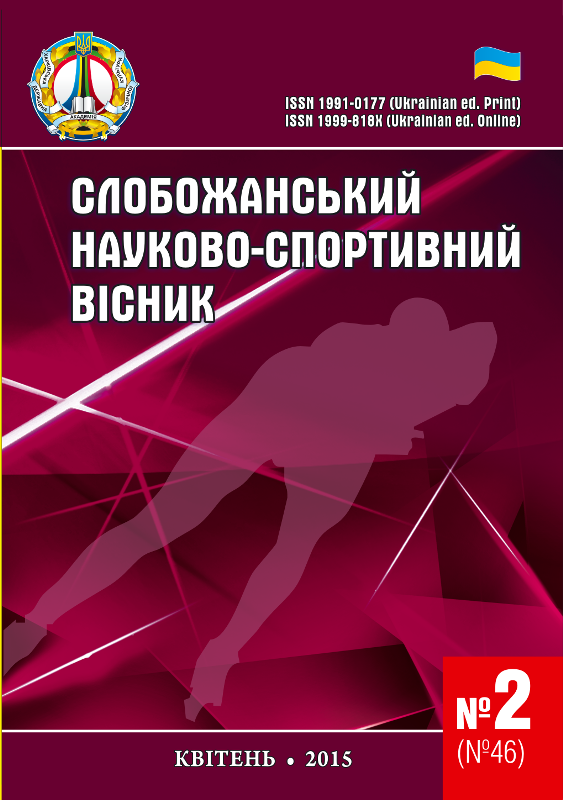Life quality and health of children and youth of Ukraine
DOI:
https://doi.org/10.15391/snsv.2015-2.029Keywords:
health, physical activity, quality of life, youthAbstract
Purpose: to describe the parameters of schoolchildren’s life quality. Material and Methods: the studies were conducted during 2012–2014 in L’viv region (Ukraine). 988 schoolchildren at the age of 15–16 years, 300 – at the age of 13–14 years, 406 – at the age of 11–12 years were surveyed with PedsQL questionnaire. Results: it was shown the respondents positively characterized the physical and social health, but their mental state was unsatisfactory. The amounts of children who had serious difficulties with basic physical activity and problems with social communication did not exceed 7%. Conclusions: the average life quality indicators were in the range 71,9–85,0 points and according scales Physical Health, Emotional Functioning, School Functioning significantly reduced with age.
References
Akhmedova R. M., Sofronova L. V. Pediatriya [Pediatry], 2012, vol. 5, pp. 122–124. (rus)
Başgül Ş. S. Parents’ perception of the quality of life of children with intellectual disabilities / Ş. S. Başgül, Öz. Ş. Üneri, N. Çakın-Memik // The Turkish Journal of Pediatricsю – 2011. – Vol. 53. – P. 541–546.
Ferreira P. L. Reliability and validity of PedsQL for Portuguese children aged 5–7 and 8–12 years / P. L. Ferreira, C. F. Baltazar, L. Cavalheiro [et al.] // Health and Quality of Life Outcomes. – 2014. – Vol. 12, № 122. – 8 p.
Health related quality of life of Dutch children: psychometric properties of the PedsQL in the Netherlands / V. Engelen, M. M. Haentjens, S. B. Detmar [et al.] // BMC Pediatrics – 2009. – Vol. 9, № 68. – 8 p.
Kobayashi K. Measuring quality of life in Japanese children: Development of the Japanese version of PedsQL / K. Kobayashi, K. Kamibeppu // Pediatrics International. – 2010. – Vol. 52. – P. 80–88.
Measurement properties of the UK-English version of the Pediatric Quality of Life Inventory™ 4.0 (PedsQL™) generic core scales / P. Upton, C. Eiser, I. Cheung, H. A. Hutchings [et al.] // Health and Quality of Life Outcomes. – 2005. – Vol. 3, № 22. – 7
p.
Measuring health-related quality of life in Hungarian children with heart disease: psychometric properties of the Hungarian version of the Pediatric Quality of Life Inventory™ 4.0 Generic Core Scales and the Cardiac Module / A. Berkes, I. Pataki, M. Kiss [et al.] // Health and Quality of Life Outcomes – 2010. – Vol. 8, № 14. – 12 p.
Quality of life among children from São Paulo, Brazil: the impact of demographic, family and socioeconomic variables / D. A. Klatchoian, C. A. Len, M. T. R. A. Terreri, M. O. E. Hilário // Cad. Saúde Pública. – 2010. – Vol. 26, № 3. – P. 631–636.
Reliability and validity of the Iranian version of the PediatricQuality of Life Inventory TM 4.0 Generic Core Scalesin adolescents / P. Amiri, E. M. Ardekani, S. Jalali-Farahani [et al.] // Qual Life Res. – 2010. – Vol. 19. – P. 1501–1508.
Svavarsdottir E. K. Health-related quality of life in Icelandic school children / E. K. Svavarsdottir, B. Orlygsdottir // Scand J Caring Sci. – 2006. – Vol. 20. – P. 209–15.
Varni J. W. Impaired health-related quality of life in children and adolescents with chronic conditions: a comparative analysis of 10 disease clusters and 33 disease categories/ severities utilizing the PedsQL™ 4.0 Generic Core Scales / J. W. Varni, C. A. Limbers, T. M. Burwinkle // Health and Quality of Life Outcomes. – 2007. – Vol. 5, № 43. – 15 p.
Downloads
Published
How to Cite
Issue
Section
License
Copyright (c) 2015 (Iuliia Pavlova) Павлова Юлія Олександрівна

This work is licensed under a Creative Commons Attribution 4.0 International License.
Our publications make use of copyright CREATIVE COMMONS open access journals.
Authors published in this journal agree to the following terms:
1 The authors reserve the right of authorship of the work and pass the journal right of first publication of this work are licensed under the Creative Commons Attribution License, which allows others to freely distribute the published work with reference to the authors of the original work and the first publication of this magazine.
2 The authors have the right to enter into separate agreements for additional non-exclusive distribution of work in the form in which it was published the magazine (such as work place electronic repository institution or publish as part of the monograph), provided that the reference to the first publication of this magazine.

 Attention, authors!
Attention, authors!


